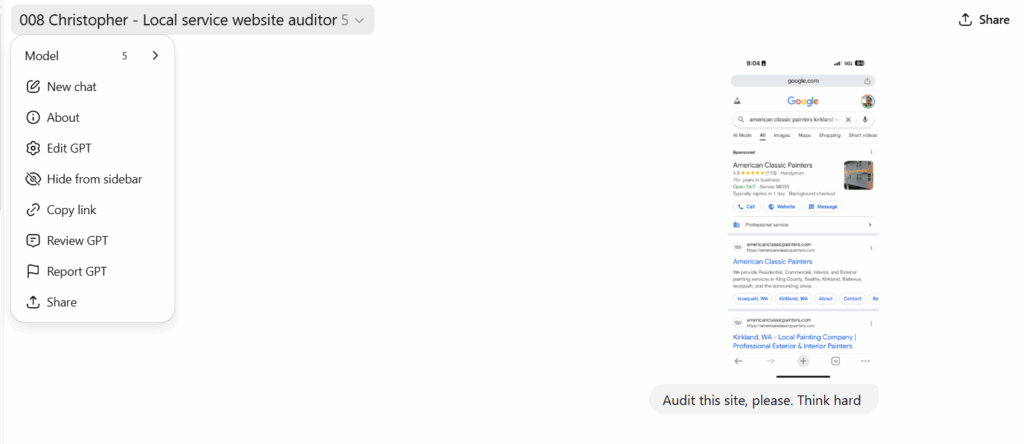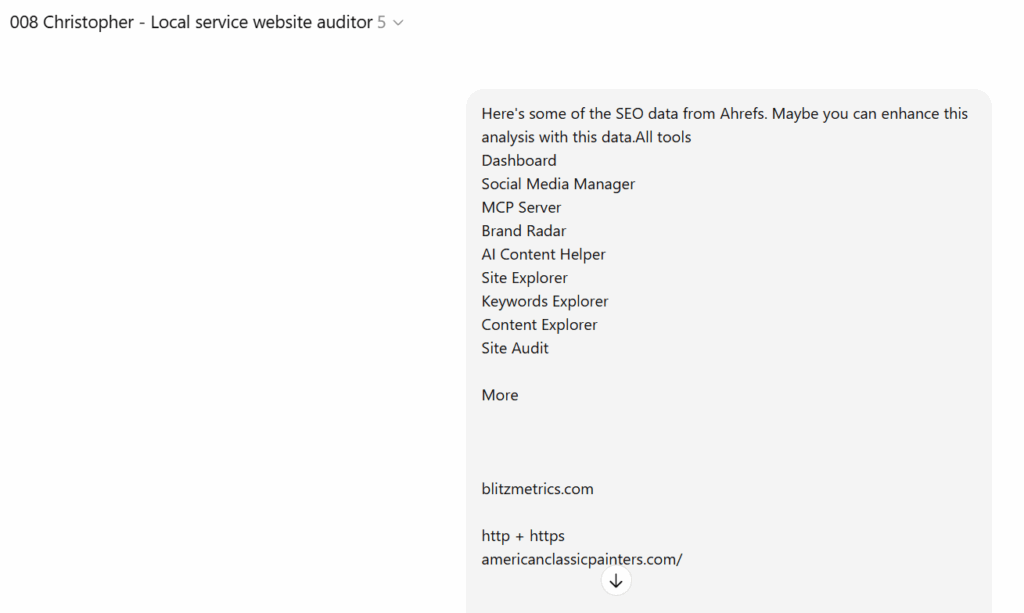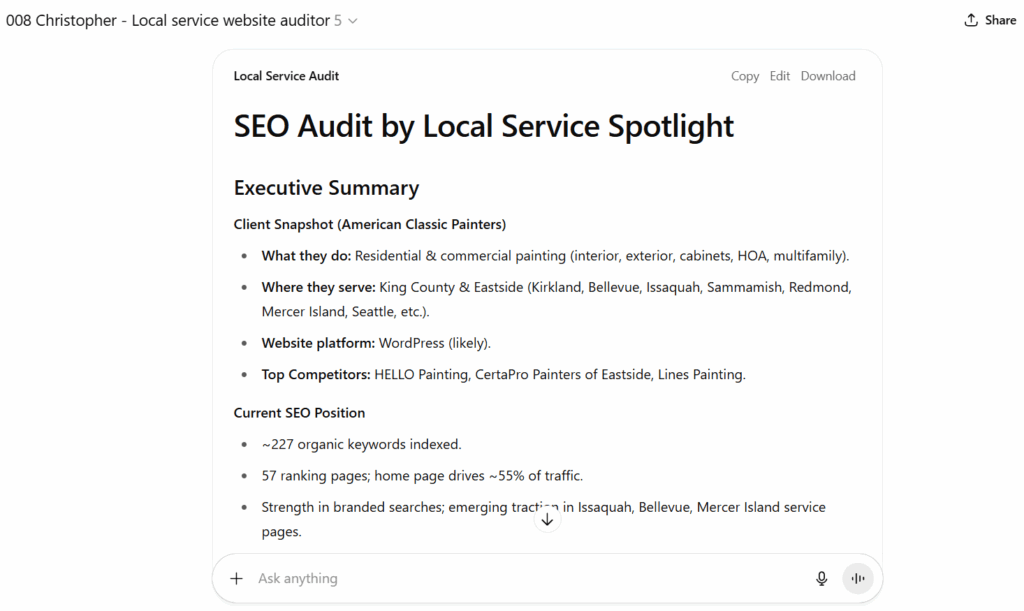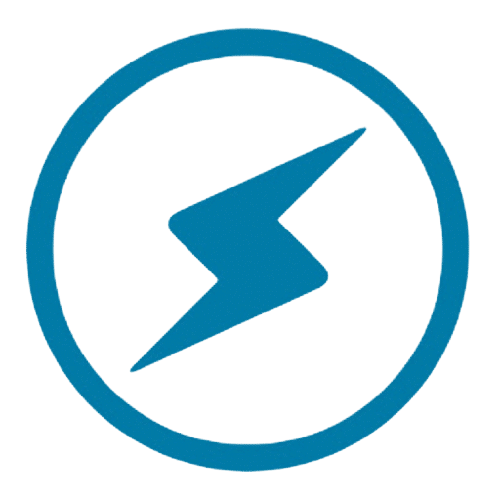We believe in documenting exactly how we do things, no smoke and mirrors, no “mystery sauce.”
The best way to scale is to make our process transparent so young adults can learn it, home service owners can see the value, and everyone wins.
This week, I ran a Quick Audit for American Home Painting, and here’s exactly how it went down.
Step 1: Start with AI analysis
We use Christopher, a custom GPT trained on our playbooks to analyze websites.
I fed the American Home Painting site into Christopher and asked it to “think hard,” not just spit out surface-level SEO notes, but really evaluate the site against what drives leads for local service businesses.

Step 2: Turn AI output into a canvas
The raw AI notes are useful but messy.
So we structure them into a canvas, a visual document that organizes findings into clear categories (SEO, content, trust signals, calls-to-action, etc.).

This way, the business owner doesn’t get lost in jargon and can see priorities at a glance.
Step 3: Layer in real data
AI insights are only half the picture.
Next, I pulled Ahrefs keyword and pages data and blended it into the canvas

This shows what the site is actually ranking for today, which pages have traction, and where the gaps are.

Step 4: Executive summary for busy owners
Most contractors don’t want to read a 12-page audit.
That’s why we add a one-page Executive Summary branded as LSS.

This top sheet highlights:
- What’s working now?
- What’s missing?
- The 2-3 highest ROI fixes.
We position it as a clear roadmap: here’s where you are, here’s where you can go, and here’s how we can help get you there.
Step 5: Package and deliver
From there, we export the whole thing as a PDF report.

The client gets this before our strategy call, so the meeting isn’t spent explaining problems from scratch.
Instead, we can dive straight into solutions and implementation.
We also make sure the automation sequence is firing:
- Socks mailed out (yes, custom face socks!).
- Login credentials to the Academy.
- Invite to our Office Hours group.
This way, the audit is the starting point of a structured customer journey, not a one-off deliverable.
Step 6: Implementation & follow-through
Finally, if the client agrees, we offer to implement the fixes.
Our agentic ChatGPT system executes the tasks, posts updates to our service platform (SPP), and keeps everything tracked.
Zoom recordings of the calls are logged in the same place.
This closes the loop: strategy → implementation → documentation.
Why this matters
The entire audit took me five minutes to run and another five to write up the process in an email.
That’s it.
When you combine trained AI with a clear system, you eliminate hours of manual work.
Even better, this is a repeatable process that young adults in our AI Apprentice program can duplicate, and soon, we’ll automate most of it through Make.com or Replit.
Quick Audit QA checklist (for ChatGPT)
- Capture business context: company name, services, service areas, primary target cities, and website URL.
- Confirm priority pages: home, top service pages, top city pages, contact, gallery/works, blog hub.
- Note competitors to benchmark (at least 3 local).
- Crawl or scan key pages (manually or with free tools) to identify obvious blockers to leads (phone visibility, CTAs, forms, trust badges, reviews, licensing, warranties).
- Identify 5 lead blockers tied to specific page sections and URLs.
- Produce 3 testable conversion hypotheses tied to those blockers.
- Evaluate EEAT: owner bio, licensing, years in business, media, certifications, project case studies; note gaps.
- Check local SEO elements: NAP consistency on site, embedded map/GBP link, city pages presence/quality, service-area clarity, LocalBusiness/Service/FAQ schema presence.
- Check on-page basics: unique titles/H1s, readable meta descriptions with service+city+CTA, header hierarchy, internal anchors, alt text on hero and gallery images.
- Draft improved titles and meta descriptions for any weak or duplicate pages.
- Map internal links needed: from top blog posts → service/city pages; from service pages ↔ city pages; from gallery/works → related services and contact.
- Propose 20+ specific in-content link placements with exact anchor text, sentence context, and destination URL; skip any that already exist.
- Standardize city page structure: unique intro (90–120 words with 2–3 neighborhoods), three city-specific benefits, 2–3 internal links, one local project case (photo + 40–60 word caption), clear CTA.
- Recommend swapping any stock/generic images with real local project photos and add short geo-specific captions.
- Validate or add JSON-LD for LocalBusiness, Service, and FAQPage where relevant; include sample markup.
- Review blog topics for topical relevance; rework or 301 off-topic posts to a relevant hub if they can’t be aligned.
- Use provided Ahrefs data to list top pages and keywords; flag pages sitting in positions ~11–20 and prioritize them for internal links and on-page refresh.
- Create a “Top 5 ROI opportunities” list: keyword → target URL (new or existing) → action (refresh, expand FAQs, add 3–5 links).
- Provide a concise Executive Summary: wins, gaps, top 2–3 fixes (with expected outcome and effort), and a 30/60/90-day plan.
- Generate a clean, scannable canvas: sections for SEO, Content, Trust, CTAs, Technical, Local; tag each item with Impact/Effort and add a 0–5 score per section.
- Include a final verification pass: evidence links/screens present, no assumptions/hallucinations, anchors varied and natural, no duplicated links, all recommended links point to correct destinations, at least one conversion fix is prioritized, and all copy is owner-friendly.
